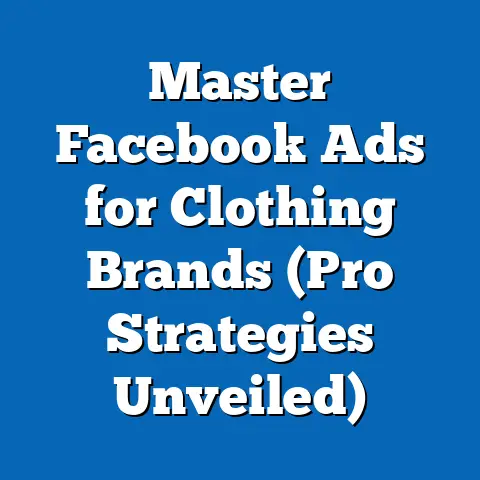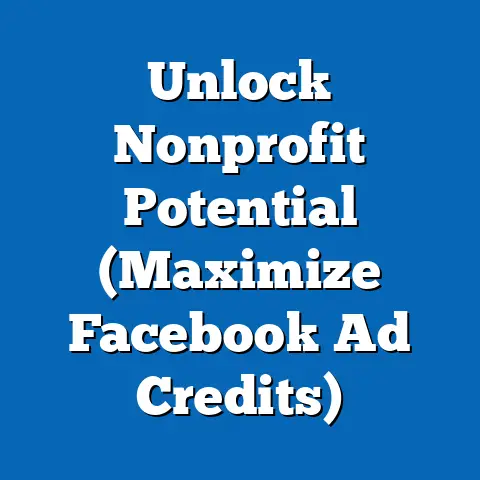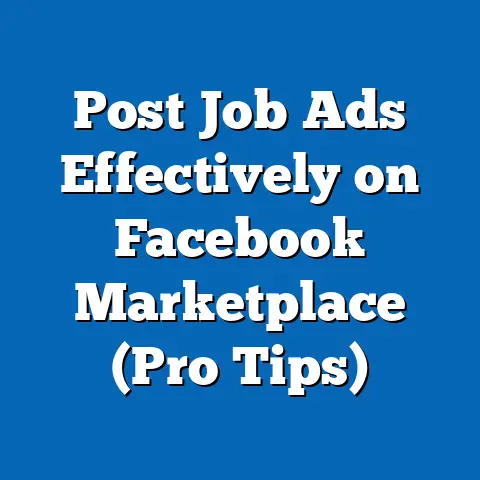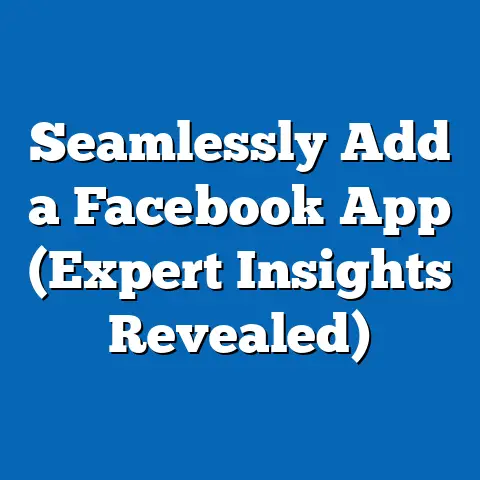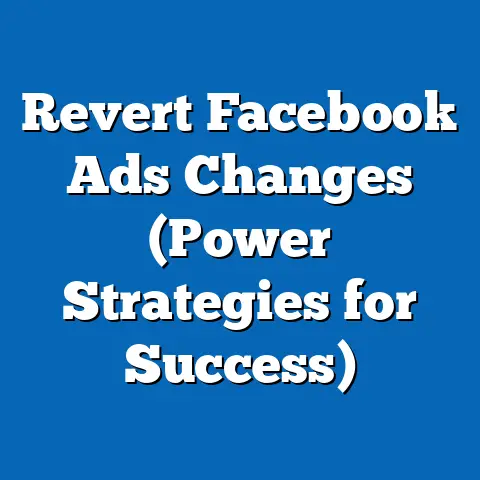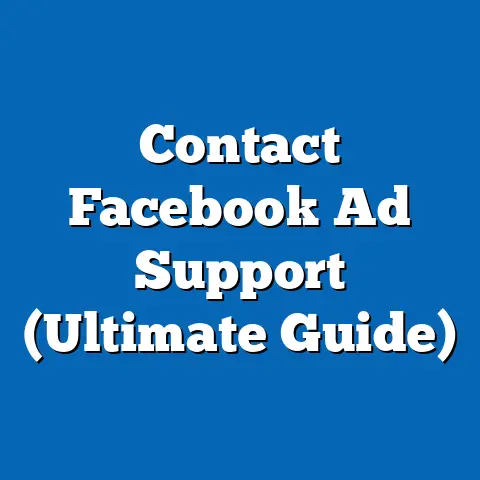Build a Profitable Facebook Ad Funnel (Expert Strategies)
Imagine Sarah, a 35-year-old entrepreneur who recently launched an online store selling eco-friendly home products. Despite having a beautifully designed website and a passionate customer base, her sales are stagnating. After months of organic social media posts yielding minimal results, she decides to invest in Facebook advertising—only to find that her ads are costing more than they’re generating in revenue.
Sarah’s story is not unique. According to a 2023 report by Statista, global digital advertising spending reached $626 billion, with social media platforms like Facebook (now Meta) accounting for nearly 21% of that share. Yet, a study by WordStream found that the average cost-per-click (CPC) for Facebook ads across industries is $1.72, and many small businesses struggle to achieve a positive return on investment (ROI) due to poorly structured ad funnels.
This article dives deep into building a profitable Facebook ad funnel using expert strategies backed by data and real-world insights. We’ll explore the latest trends in Facebook advertising, demographic targeting nuances, and step-by-step methodologies to optimize every stage of the funnel. Whether you’re a small business owner like Sarah or a seasoned marketer, these strategies will help you maximize your ad spend and drive sustainable growth.
Section 1: Understanding the Facebook Ad Funnel
What Is a Facebook Ad Funnel?
A Facebook ad funnel is a structured marketing framework designed to guide potential customers through distinct stages of the buying journey: awareness, consideration, conversion, and retention. Unlike traditional advertising, which often focuses on immediate sales, a funnel approach nurtures leads over time, increasing the likelihood of conversion. Each stage requires tailored ad creatives, messaging, and targeting to align with the user’s mindset.
According to a 2022 report by HubSpot, 74% of consumers feel frustrated when content is irrelevant to them. A well-designed funnel mitigates this by delivering the right message at the right time. For instance, top-of-funnel (TOFU) ads focus on brand awareness, while bottom-of-funnel (BOFU) ads push for direct purchases with urgency-driven offers.
Why Facebook for Ad Funnels?
Facebook remains a dominant platform for digital advertising, with over 2.9 billion monthly active users as of Q2 2023, per Meta’s official reports. This vast user base spans diverse demographics, making it a versatile platform for businesses of all sizes. Additionally, Facebook’s advanced targeting options—such as interest-based targeting, lookalike audiences, and retargeting—allow marketers to reach highly specific audiences.
A 2023 survey by eMarketer revealed that 68% of U.S. marketers consider Facebook their most effective social media advertising platform, citing its robust analytics and cost-effectiveness compared to competitors like Google Ads. However, success hinges on a strategic funnel approach rather than sporadic, unconnected campaigns.
Section 2: Key Trends and Statistics in Facebook Advertising
Current Trends Shaping Facebook Ads
Facebook advertising has evolved significantly over the past decade, driven by technological advancements and shifting consumer behaviors. One major trend is the rise of video content, with a 2023 report by Social Media Examiner indicating that 66% of marketers plan to increase their use of video ads on Facebook due to higher engagement rates. Short-form videos, in particular, have seen a 30% increase in click-through rates (CTR) compared to static images, per a study by Wyzowl.
Another trend is the growing emphasis on privacy and data regulations. With Apple’s iOS 14.5 update in 2021 introducing App Tracking Transparency (ATT), Meta reported a $10 billion loss in ad revenue in 2022 due to reduced tracking capabilities. Marketers must now rely more on first-party data and creative testing to maintain effectiveness.
Historical vs. Current Performance
Historically, Facebook ads were lauded for their low CPC and high ROI. In 2015, the average CPC was just $0.27, according to WordStream data, compared to $1.72 in 2023—a 537% increase. This rise reflects growing competition and platform saturation, underscoring the need for optimized funnels over brute-force ad spend.
Despite the higher costs, conversion rates have remained relatively stable, averaging 9.21% across industries in 2023 (WordStream). Industries like fitness (14.29%) and education (13.58%) report above-average conversion rates, while luxury goods (3.21%) lag behind, highlighting the importance of industry-specific strategies.
Demographic Insights
Facebook’s user base is diverse, but certain demographics dominate ad engagement. According to Pew Research Center (2023), 70% of U.S. adults aged 18-29 use Facebook daily, compared to 54% of those aged 50-64. Gender-wise, women are slightly more active (75% usage rate) than men (63%).
For advertisers, understanding these patterns is crucial. For example, a 2022 Meta study found that women aged 25-34 are 20% more likely to engage with lifestyle and beauty ads, while men aged 18-24 show higher engagement with gaming and tech content. Tailoring funnel messaging to these demographic preferences can significantly boost performance.
Section 3: Building a Profitable Facebook Ad Funnel – Step-by-Step Strategies
Step 1: Define Your Funnel Objectives and Audience
Before launching any campaign, clarity on objectives is essential. Are you aiming for brand awareness, lead generation, or direct sales? A 2023 survey by Hootsuite found that 52% of failed Facebook ad campaigns stem from unclear goals or mismatched targeting.
Start by creating detailed buyer personas. Use Facebook’s Audience Insights tool to analyze demographics, interests, and behaviors of your ideal customers. For instance, if you’re selling eco-friendly products like Sarah, target users interested in sustainability, zero-waste lifestyles, and organic brands—potentially reaching an audience of 45 million users globally, per Meta’s 2023 data.
Step 2: Craft Compelling Top-of-Funnel (TOFU) Content
The TOFU stage focuses on building awareness and capturing attention. Use eye-catching visuals or videos to introduce your brand without pushing for a hard sell. According to Meta, ads with video content achieve a 6% higher CTR than static images at this stage.
Consider broad targeting to maximize reach, but avoid overly generic audiences. For example, instead of targeting “all women aged 25-54,” narrow it to “women aged 25-54 interested in eco-friendly products.” A real-world case study by Buffer showed that refined TOFU targeting reduced cost-per-impression (CPM) by 15% while increasing engagement by 22%.
Data Visualization Description: Imagine a bar chart comparing CTRs for video ads (6%) versus static image ads (4.5%) at the TOFU stage, highlighting the effectiveness of dynamic content.
Step 3: Nurture Leads at the Middle-of-Funnel (MOFU)
At the MOFU stage, your goal is to build trust and educate potential customers. Use lead magnets like free eBooks, webinars, or discount codes to collect contact information. A 2022 report by OptinMonster found that lead generation ads on Facebook have an average conversion rate of 8.5% when paired with valuable incentives.
Retargeting is critical here. Facebook’s Custom Audiences feature lets you target users who engaged with your TOFU ads but didn’t convert. A study by AdRoll revealed that retargeted ads have a 10x higher CTR compared to display ads targeting new users.
Step 4: Drive Conversions at the Bottom-of-Funnel (BOFU)
BOFU ads focus on closing the sale with urgency-driven messaging, such as limited-time offers or scarcity tactics (“Only 5 left in stock!”). Dynamic Product Ads (DPAs) are particularly effective, showcasing products users have previously viewed. Meta reports that DPAs generate 3x higher conversion rates compared to standard catalog ads.
Optimize for conversions by using Facebook’s Conversion Objective in Ads Manager. Test different calls-to-action (CTAs) like “Buy Now” versus “Shop Today”—a 2023 experiment by Social Media Today found that action-oriented CTAs increase click-through rates by 18%.
Step 5: Retain and Re-engage Customers Post-Conversion
Retention is often overlooked, yet it’s far cheaper to retain customers than acquire new ones. According to Harvard Business Review, increasing customer retention rates by 5% can boost profits by 25-95%. Use Facebook ads to upsell complementary products or offer loyalty discounts.
Create Custom Audiences of past purchasers and target them with personalized offers. A 2022 case study by Shopify showed that personalized retargeting ads for existing customers resulted in a 35% higher repeat purchase rate compared to generic promotions.
Section 4: Advanced Strategies for Maximizing ROI
Leverage Lookalike Audiences
Lookalike Audiences allow you to target users similar to your best customers, based on data from your website pixel or customer lists. Meta claims that Lookalike Audiences can increase campaign reach by up to 50% while maintaining relevance. Start with a 1% lookalike audience for precision, then scale to 3-5% as needed.
Optimize Ad Creative and Copy
Creative fatigue is real—ads lose effectiveness after 2-3 weeks of exposure. A 2023 study by Creatopy found that refreshing ad creatives every 14 days can boost CTR by 25%. Test multiple variations using Facebook’s A/B testing feature to identify high-performing elements like headlines, images, or colors.
Copy should be concise and benefit-focused. For instance, instead of “Buy Our Eco-Friendly Candles,” try “Save the Planet with Every Purchase—Shop Eco Candles Now!” Data from CoSchedule indicates that emotionally charged copy increases engagement by 31%.
Monitor and Adjust with Analytics
Facebook Ads Manager provides granular data on metrics like CTR, CPC, and conversion rates. A 2023 benchmark by WordStream suggests aiming for a CTR of at least 2% and a conversion rate of 9% to ensure profitability. Use this data to pause underperforming ads and scale winners.
Data Visualization Description: Picture a line graph showing a campaign’s CTR declining from 2.5% to 1.2% over 14 days, with a spike to 2.8% after refreshing creatives, illustrating the impact of creative updates.
Section 5: Common Pitfalls and How to Avoid Them
Over-Targeting or Under-Targeting
Striking the right balance in audience targeting is critical. Over-targeting (e.g., a tiny audience of 1,000 users) can drive up costs, with CPMs increasing by 37%, per a 2022 Meta analysis. Conversely, under-targeting (e.g., an audience of 10 million with no filters) dilutes relevance, reducing CTR by up to 50%.
Solution: Aim for audience sizes between 500,000 and 2 million for broad campaigns, and 50,000-200,000 for retargeting, adjusting based on performance data.
Ignoring Mobile Optimization
With 98.5% of Facebook users accessing the platform via mobile devices (Statista, 2023), non-mobile-optimized ads are a recipe for failure. Ads with slow-loading landing pages or poor mobile formatting see a 20% higher bounce rate, per Google’s mobile usability data.
Solution: Use vertical video formats (9:16) for Stories and Reels, and ensure landing pages load in under 3 seconds. Test mobile responsiveness using tools like Google’s Mobile-Friendly Test.
Neglecting Budget Allocation
Many advertisers allocate budgets evenly across funnel stages, which is inefficient. A 2023 study by MarketingSherpa found that allocating 50-60% of budget to TOFU for reach, 30% to MOFU for nurturing, and 10-20% to BOFU for conversions yields a 15% higher overall ROI.
Solution: Start with a top-heavy budget, then shift funds to lower funnel stages as you build a retargeting pool.
Section 6: Case Studies and Real-World Examples
Case Study 1: Eco-Friendly Brand Success
A small eco-friendly brand (similar to Sarah’s hypothetical business) implemented a three-stage funnel in 2022. They spent $5,000 on TOFU video ads targeting 1.2 million users, achieving a 3.5% CTR and 50,000 engagements. MOFU lead ads collected 2,000 emails at a cost of $2.50 per lead, and BOFU retargeting ads converted 10% of leads into sales, generating $15,000 in revenue—a 3x ROI.
Key takeaway: Consistent messaging across funnel stages and retargeting drove profitability.
Case Study 2: E-Commerce Retailer Scaling with Lookalikes
An e-commerce retailer used Lookalike Audiences based on their top 1% of customers, reaching 800,000 similar users. Their campaign saw a 4.2% CTR and a 12% conversion rate, reducing CPC by 22% compared to broad targeting. Total ad spend of $10,000 resulted in $35,000 in sales over 30 days.
Key takeaway: Data-driven audience expansion can lower costs while maintaining high performance.
Section 7: Broader Implications and Future Trends
Building a profitable Facebook ad funnel is not just about immediate sales—it’s about creating a sustainable system for customer acquisition and retention. As privacy regulations tighten and competition grows, marketers must prioritize creativity, first-party data, and audience relevance to stay ahead. The rise of AI tools in Meta’s ecosystem, such as Advantage+ campaigns, suggests automation will play a larger role, with early adopters reporting 20% lower CPCs in 2023 trials (Meta data).
Moreover, the shift toward short-form video and interactive formats like Reels signals a need for brands to adapt to changing user preferences. Businesses that invest in agile, data-driven funnel strategies will be best positioned to thrive in an increasingly dynamic advertising landscape.
For entrepreneurs like Sarah, the journey from ad frustration to profitability is achievable with the right framework. By understanding funnel mechanics, leveraging demographic insights, and continuously optimizing based on data, any business can turn Facebook ads into a powerful growth engine.

